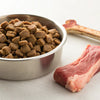When Can Dogs Eat Dry Food? A Comprehensive Guide for Puppy Parents
- Houndsy
Table of Contents
- Introduction
- Understanding Puppy Development and Nutritional Needs
- When Are Puppies Ready to Try Solid Foods?
- Starting the Weaning Process
- What Should You Look for When Choosing Puppy Food?
- Setting Up Your Puppy’s Feeding Schedule With Ease
- Challenges, Transitioning, and Feeding Tips
- Wrapping It Up
Introduction
Did you know that puppies can gain up to 5% of their body weight each day during their first few weeks of life? This rapid growth brings with it a crucial question for new puppy parents: When can dogs eat dry food? Transitioning a puppy from a liquid diet to solid food is not just a milestone; it’s a vital step in ensuring their healthy growth and development. As pet owners, we want to provide our furry friends with the best nutrition possible, but the shift from milk to kibble can often be confusing.
In this blog post, we will explore the intricacies of puppy nutrition, focusing on when and how to introduce dry food. By the end, you'll have a clear understanding of the feeding timeline, signs that indicate readiness for dry food, and tips for making the transition smooth. We invite you to reflect on your own pet feeding routines as we delve into this essential topic.
Our mission at Houndsy is to simplify and elevate the dog-feeding experience, ensuring that both you and your pet enjoy mealtime. So, let's dive into the world of puppy nutrition!
Understanding Puppy Development and Nutritional Needs
Puppies experience rapid growth in their early months, requiring specialized nutrition to support their developing bodies. During the first few weeks of life, they rely heavily on their mother’s milk, which provides essential nutrients and antibodies. As they approach the weaning stage—typically around 4 to 5 weeks of age—puppies begin to show signs of readiness for solid food.
Nutritional Essentials for Growing Puppies
- Protein: Essential for muscle growth and development, protein is a critical component of a puppy's diet.
- Fats: Healthy fats provide energy and support overall health, including a shiny coat and healthy skin.
- Vitamins and Minerals: Calcium and phosphorus play a key role in bone development, while vitamins A, D, and E are crucial for overall health.
- DHA: An omega-3 fatty acid that supports brain development and cognitive function.
These nutritional elements are vital for a puppy’s growth, and it's essential to choose a high-quality puppy food that meets these needs. As a loving pet parent, understanding these requirements will help you make informed decisions about your puppy’s diet.
When Are Puppies Ready to Try Solid Foods?
Puppies typically begin the weaning process around 3 to 4 weeks of age. This period is marked by the gradual transition from their mother's milk to solid food. While every puppy is unique, there are common signs to watch for that indicate readiness for solid food:
Signs Your Puppy is Ready for Dry Food
- Teething: As puppies begin to develop their baby teeth, they may show interest in chewing, indicating they can handle more solid textures.
- Curiosity About Food: If your puppy starts sniffing around your meals or their siblings’ dishes, it’s a clear sign they are ready to explore different foods.
- Steady Weight Gain: Healthy weight gain is a good indicator that your puppy is developing well and may be ready for a variety of food textures.
- Increased Activity: A sudden burst of energy can mean your puppy needs more sustenance, which is a great time to introduce solid food.
Picking Up on the Signs
As you observe your puppy, keep an eye out for these behaviors. If they are showing interest in solid food and seem to be ready, it may be time to introduce them to dry food. This transition can be exciting, and as responsible pet owners, we must ensure it is done right.
Starting the Weaning Process
When you determine your puppy is ready for solid food, it’s time to start the weaning process. This can be done gradually to ensure your puppy adjusts comfortably.
How to Start the Weaning Process
- Introduce Gruel: Start by mixing high-quality dry puppy food with warm water or a puppy milk replacer to create a mushy consistency. A good ratio is 3 parts food to 1 part liquid.
- Feeding Schedule: Offer this mixture up to four times a day, allowing your puppy to eat as much as they desire within a 20-minute timeframe.
- Gradually Thicken: As your puppy becomes accustomed to the gruel, gradually decrease the amount of liquid, allowing them to adjust to thicker textures.
- Introduce Kibble: Once your puppy is comfortable with thicker gruel, you can start mixing in small amounts of dry kibble to help them transition from soft to solid food.
By following this gradual approach, you can help your puppy adapt to their new diet without overwhelming their developing digestive system.
What Should You Look for When Choosing Puppy Food?
Choosing the right food for your puppy is crucial for their health and development. Here’s what to consider:
Key Factors in Selecting Puppy Food
- Quality Ingredients: Look for foods that list real meat, vegetables, and wholesome grains as the primary ingredients. Avoid fillers or artificial additives.
- Nutritional Content: Ensure the food is specially formulated for puppies, containing the right balance of protein, fat, vitamins, and minerals.
- Breed Considerations: Different breeds may have specific nutritional needs. Large breeds, for instance, require controlled growth to prevent skeletal issues, so consider breed size when choosing food.
- Allergies and Sensitivities: Be mindful of any allergies your puppy may have. If you notice any adverse reactions, consult your veterinarian for suitable alternatives.
By focusing on high-quality, nutrient-rich puppy food, you can set your furry friend up for a healthy start in life.
Setting Up Your Puppy’s Feeding Schedule With Ease
Establishing a consistent feeding routine is essential for your puppy's well-being. It helps regulate their digestive system and sets expectations for mealtime.
Recommended Feeding Schedule
- 3-6 Weeks: Feed a soft gruel mixture 4 times a day.
- 6-8 Weeks: Transition to a thicker mixture with less liquid while still offering 4 meals a day.
- 8 Weeks and Beyond: As your puppy adjusts to solid food, you can gradually reduce feeding to three meals a day, and eventually to two meals as they approach adulthood.
This structured approach helps manage your puppy's hunger and ensures they receive adequate nutrition throughout their growth stages.
Challenges, Transitioning, and Feeding Tips
Transitioning from a liquid diet to dry food can come with challenges. Here are some tips to help ease the process:
Common Challenges and Solutions
- Reluctance to Eat: If your puppy is hesitant to eat dry food, consider lightly moistening it with water or broth to enhance its appeal.
- Digestive Upset: If you notice signs of digestive distress, such as diarrhea, revert to a softer diet and consult your veterinarian.
- Inconsistent Feeding Habits: Puppies are naturally curious and may get distracted. Ensure a calm feeding environment, free from distractions, to encourage focused eating.
Additional Feeding Tips
- Monitor Growth: Keep track of your puppy’s weight and growth progress. Adjust feeding portions as needed based on their activity levels and overall condition.
- Consult Your Veterinarian: If you have any concerns about your puppy’s diet or health, don’t hesitate to reach out to your veterinarian for personalized advice.
Wrapping It Up
Transitioning your puppy from a liquid diet to dry food is an essential part of their development. By understanding their nutritional needs, recognizing the signs of readiness, and following a structured feeding routine, you can help them thrive during this crucial stage of life.
At Houndsy, we believe that elevating the feeding experience is key to nurturing your pet’s health and happiness. Our flagship product, the Houndsy Kibble Dispenser, is designed to make feeding a breeze, ensuring you can serve perfect portions every time, all while complementing your modern home decor.
Final Thoughts
As we conclude this guide, we encourage you to reflect on your puppy's feeding journey. Are you ready to make the transition to dry food? How can you enhance your puppy’s feeding experience? We’re here to support you every step of the way, ensuring that mealtime is a positive and enriching experience for both you and your furry companion.
FAQ
1. When can puppies start eating dry food?
Puppies can typically begin to transition to dry food around 8 to 10 weeks of age, following a gradual weaning process that starts around 4 to 5 weeks.
2. How should I introduce dry food to my puppy?
Start by mixing dry food with warm water to create a mushy gruel, gradually reducing the moisture until they can eat dry kibble.
3. What if my puppy refuses to eat dry food?
If your puppy is hesitant, try moistening the kibble or mixing in a small amount of wet food to entice them.
4. How often should I feed my puppy?
Puppies should be fed 3 to 4 times a day until they are about 6 months old, after which you can reduce to two meals a day.
5. What type of food should I choose for my puppy?
Look for high-quality puppy food that contains real meat, essential nutrients, and is formulated specifically for puppies to support their growth and health.
By following these guidelines and using the Houndsy Kibble Dispenser, you can create a positive and healthy feeding experience for your puppy, setting the stage for their lifelong health and happiness.












